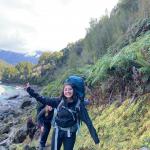Support
I was born and raised in Mexico City, a concrete jungle. Being in New Zealand for a semester is a dream for any outdoors and nature lover. As an Economics and Environmental Studies double major and Statistics minor, my time abroad gave me the opportunity to see how these disciplines interconnect outside theory. Through my semester, I learned so much about endangered species, environmental management, grassroot movements, and indigenous environmental knowledge. I am grateful for having the opportunity to enrich my abroad experience and share it with the SLU community.
With the Enrichment Grant I had the opportunity to travel during my mid semester break and bike in the New Zealand “winterless north”. Pou Herenga Tai - Twin Coast Cycle Trail can be ridden all year round due to its sub-tropical climate, hence the name. Bike trails are important for New Zealand’s ecotourism because people interact uniquely with the culture and environment. Most of my experiences biking are within urban landscapes, since I use my bike to transit. For me, being able to explore one of the most remote and scenic trails in New Zealand was a breathtaking adventure.
The trail travels from the Bay of Islands to the Hokianga Harbour, or vice versa. I decided to bike the 87 kilometers in two days, going from the East coast to the West coast. During the first day I biked next to the old railroad and farmlands, it was just me, nature, and uncountable cows and sheep. Luckily, I made to Kaikohe just few minutes before darkness, it is a small town which is known for its natural hot pools. The Ngawha Springs, which the Maori discovered in the late 1600s, have different types of mineral pools- with a variety of temperatures- bubble from the ground into large wooden tubs. After a long day of biking, a hot pool was all my muscles and mind needed to recover. The Maori community manages the place and they explained me some of the physical and spiritual benefits from the hot pools. I relaxed and met new people under one of the starriest nights I have ever seen.
Next day I was fresh and ready for the second half of my trip. The last part of the trail is along the valley and its river that lead to the Mangungu Mission Station, the end of the track. This was my favorite part as I biked through hills, forest, and more variety of wild flora and fauna. The rail is focused in bicultural heritage and transitioning scenery. One of the purposes of cycling this trail was to get to know more about relation of locals and tourists with nature. I held interesting conversations with the hostel manager and other bikers about how they perceived the relation of tourism with nature conservation.
I want to thank the Giltz Family Fund for International and Intercultural Education for funding this experience. By exploring one of the most remote places on Earth, I admired spectacular nature and learn about effective and responsible tourism and conservation.
